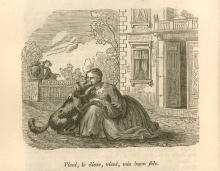For Beasts, Against Savages: Towards the Long History of Animal Rights Movement
Principal Investigator at ZRC SAZU
Daša Ličen, PhD-
Original Title
Za zveri, proti divjakom: K dolgi zgodovini gibanja za pravice živali
Project Team
-
ARIS Project ID
Z6-4613
-
Duration
1 November 2022–31 December 2024 -
Link to SICRIS
19745 -
Financial Source
Agencija RS za raziskovalno dejavnost

The project traces animal rights movement back to the 19th century when caring animal owners first started treating their animals as family members. It aims to examine the animal rights movement as a class phenomenon that distinguished the growing bourgeoisie from the working classes. In this sense, the research focus is on human relationships and human-animal relationships not the animals themselves. This focus remains the same also in the second phase of the project, in which the researcher ethnographically traces the persistence of 19th century animal care until today.
In the first part of the research, the focus is on animal welfare activists in late Habsburg Trieste and similar associations in nearby cities. The sources suggest the growing animal rights movement was an elite ambition. It is, however, not certain if members of these organizations were driven only by their love of animals. To explain, members often complained of “uncivilized torturers” and “cruel barbarians” who did not treat their animals well. The proponents of animal rights based their opinions on their own limited experiences with the animal world. For the elite, animals were companions, toys, and aesthetic objects; this was vastly different from the experiences of farmers and workers who depended on animals for their livelihood. In their efforts, privileged animal lovers wanted to “re-educate” the lower classes, teach them “proper morals,” and keep their rural values out of the city. The critical discourse the members used to influence lower classes calls the seemingly obvious benevolence of the members into question. Is it possible that animal lovers readily sympathized more with animals than with other humans?
The longue durée of the animal rights movement is central to the second part of the project. By public shaming, advancing the discourse, fighting for a new legal language, and willingly assisting the state authorities in disciplining supposedly heartless animal owners, the animal rights movement permanently changed attitudes and practices towards animals. We remain the heirs of the movement when many seem to care more about abuse of animals than of humans. A survey conducted by three American sociologists indicated that respondents were less distressed by seeing human adults victimized than seeing dogs victimized (Levin, Arluke and Irvine 2007). In the second part, the research aims to illuminate the extent to which ideas spread by the 19th century animal rights activists still constitute human–animal relations today. More precisely, is the way people treat animals a means of separating the “kind” from the “cruel,” and the elites from peasants and workers? These answers will be obtained from an ethnographic study of animal welfare associations and activists in contemporary Trieste and Ljubljana.
Against ‘plebeian ignorance’ for ‘civilised behaviour’. Late Habsburg Trieste’s Società Zoofila as an Instrument in the Hands of the Bourgeoisie. For Beasts, Against Savages Workshop, Zreče, 10.–11. 9. 2023.
The Habsburg Empire: Tamed and Untamed. Presentation at the Workshop On Animal History, Institute für Wirtschafts– und Sozialgeschichte, Dunaj/Wien, 9.–10. 4. 2025. Schedule: Workshop on Animal History.pdf
